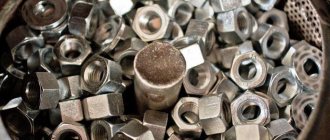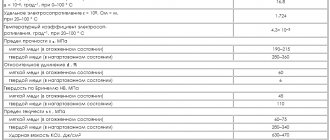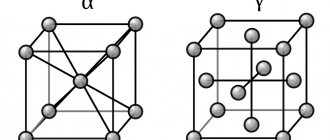Metallurgy and metalworking are the basis of the existence and development of human civilization, since it was the beginning of the extraction and use of metals in everyday life that caused the evolution of society from the Stone Age to more developed forms. A special place in metallurgy is occupied by the creation of alloys, evidence of which is bronze, which became the basis for the emergence of the concept of the “Bronze Age”. An alloy is a mixture of several chemical elements that give the final product certain properties. There is a huge variety of alloys and methods for creating them. Of particular importance in this list is an alloy of zinc and copper, also called brass.
History of appearance and application
Brass has been known since the beginning of the new era and was first produced in the Roman Empire, but was also used in India and China. Later, the method of smelting zinc was lost in Europe, so for a long time the metal was imported from Asia. Zinc mining in Europe resumed in the 16th century, and brass smelting began in the 19th century. Thanks to archaeological excavations, it is known that brass was widely used for jewelry, as it has the characteristic yellow color of gold and is called “fake gold.” With the development of metallurgy, the alloy expanded its scope of application, which was ensured by regulating the characteristics of the metal by varying the ratio of its components.
How to distinguish gold from brass
Even though gold and brass look similar, there are ways to tell one from the other. This is checked as follows:
- Gold has a more saturated color. In addition, over time, brass darkens because it oxidizes in air, but gold does not.
- If you put a magnet near it, brass will be attracted, but gold will not.
- Brass has a higher density, which means it is heavier. This is noticeable when throwing pieces of metal in your palms.
- Availability of sample.
- If you test with acid, the gold will not react and the brass will discolor.
Properties of copper and zinc alloy
There are several types of brass, which are characterized by both general properties and individual ones. Main characteristics:
- metal density - from 8.2 to 8.7 t/m3;
- heat capacity - 380 J/(kg*K);
- electrical resistance - from 0.025 to 0.108 Ohm*sq. Mmm;
- melting point - from 870 to 990 degrees.
Both main elements have a relatively high density. Accordingly, their connection is characterized by high mass. Brass is easily processed by arc welding, but will not respond to gas welding. It oxidizes quickly, so if necessary, the metal is coated with varnish or polished. Zinc provides strength and ductility. The latter can be regulated by zinc content.
Certain properties are imparted by alloying additives, which change the composition of brass and allow its characteristics to be adjusted over a wide range. A feature of the additives is the absence of changes in the specific gravity of the alloy. The addition of magnesium increases strength and anti-corrosion qualities. Nickel reduces oxidation and lead improves ductility. If you add silicon without other additives, the ductility and strength will increase. There are many combinations of zinc, copper and additive ratios that provide the desired performance.
Other meanings of this word:
Random riddle:
What five-letter word has five o's?
Random joke:
Two armies stand with their muskets pointed at each other. “Gentlemen, shoot first,” the lieutenant nobly offers to the French musketeers. - No, gentlemen. “You shoot first,” they answer the English. “Shoot first, gentlemen,” the Frenchman insists. “No, you,” the British are stubborn. “Shoot, gentlemen,” the lieutenant continues to call. “No, gentlemen, you,” the British say. . It was the eighty-seventh year of the Hundred Years' War.
Did you know?
The smallest adult monkey, the size of a rat, fits quite comfortably in the palm of your hand!
Scanwords, crosswords, sudoku, keywords online
Source
Classification and marking of brass
The zinc content in the metal can vary from 5 to 45 percent. With a zinc content of up to 20 percent, brass is called red or tombak, and above 20% - yellow. An alloy containing only zinc and copper is two-component, while an alloy containing additives is multi-component. According to the scope of application, brass can be divided into casting, wrought, and automatic.
Regarding the composition of the metal, it is marked according to GOST standards. Brass by qualification is designated by the letter “L”, then there are designations of additives with numbers that indicate the percentage of copper and additives. For example, LO70−1, where 70% is copper, 1% is tin and, accordingly, zinc is not indicated, of which there is 29% . Casting alloys have a different marking: the quantitative content is indicated after the letter, and zinc is indicated instead of copper. For example, the marking of the above alloy has been redone - LTs29O1.
Production of material
All components that make up the alloy have different melting points. This creates difficulties when melting brass. During the work process, components are added in a certain sequence.
The production scheme looks like this:
- Extraction of copper and zinc from ore.
- Fuse. The copper is heated first, and then the other components.
- Forming ingots by pouring molten metal into molds.
- They arrive at the rolling shop, where the metal is processed in order to deform the ingots.
- Annealing and etching.
Areas of use of alloys
The annual smelting of the alloy amounts to more than two million tons, while half is made from recycled materials. Depending on the scope of application, brass is divided into:
- wrought - alloys with a zinc content of less than 10%, which provides ductility, pressure treatment, corrosion resistance and a low level of friction with other metals. Characteristic appearance is “gold”;
- foundry - alloys with a zinc content of 20 to 45 percent. Used for casting pipes, wires, angles and other products that will be exposed to aggressive influences. Characterized by ductility, strength and stability;
- automatic, containing lead, which ensures automatic processing of brass products on machines.
Stamping of deformable products is widely used in shipbuilding, mechanical engineering, aviation, as well as decoration and the manufacture of cultural objects. Foundry production provides kilometers of rolled products annually, and automatic production produces screws, bolts, nuts, etc. Making jewelry from brass has been known since antiquity. Brass is used in all spheres of society, and it is impossible to abandon it in the near future.
Zinc, Zn
Latin name Zincum, chemical symbol Zn. Element of period 4, located in group II, B-subgroup. Serial number 30. Mass - 65.37. Structure of electronic shells: 1s2 2s22p6 3s23p63d10 4s2 (in the ground state). Valency and oxidation state: II(+) and +2 (respectively).
Methods of production in industry:
- Reduction by carbon upon heating: ZnO+ C→ CO↑ + Zn.
- Hydrometallurgy: ZnO + H2SO4 → ZnSO4+ H2O; ZnSO4+ Fe → FeSO4+ Zn↓.
- Electrolysis: zinc is reduced at the cathode Zn2+ + 2H+ + 4ē → Zn↓ + H2.
Zinc is a silver-gray metal ( Fig. 3 ). Solid, conducts heat and electricity. Oxidized by oxygen when heated. Does not interact with boron, carbon, silicon, nitrogen. It does not dissolve in water, but upon strong heating it reacts with water vapor to form zinc oxide and release hydrogen. Reacts with acids other than nitric acid, displacing hydrogen. Displaces metals located to the right in the activity series from solutions of their salts.
Rice. 3. Zinc
table 2
Characteristics of connections
| Substance classes | Names and formulas | Properties |
| Oxides | Zinc oxide, ZnO | Amphoteric. |
| Hydroxides | Zinc hydroxide Zn(OH)2 | Amphoteric. |
Zinc is used as a protective material to prevent rust (galvanizing) of steel and iron products. The metal is used in construction, the production of household appliances and for other purposes.
Other meanings of this word:
Random riddle:
The lanky man walked, got stuck in the damp ground.
Random joke:
Crying parents come to the guardhouse at the foot of the mountain and say: “Yesterday our son went to the mountains to ski, and he still hasn’t returned!” - Wait a bit. What is the name of your son? - Genrikh Pupkin! - Yandex, come to me! A healthy St. Bernard runs up and says to him: “Genrikh Pupkin, understand?” Search! After some time, Yandex returns and says: “Nothing was found in the mountains according to your request.” Found 283265 Heinrichs and 222388 Pupkins. Maybe look in the valley?
Did you know?
In 1966, health warnings about cigarettes appeared on cigarette packages.
Scanwords, crosswords, sudoku, keywords online
Source
Other meanings of this word:
Random riddle:
Two snub-nosed girlfriends did not leave each other behind. Both run in the snow, Both sing songs, Both ribbons in the snow are left in the snow!
Random joke:
Lenochka yells in kind obscenities: “Mom, mom, Vovochka showed me the facts!” Mom runs into the children's room and grabs the bastard Vovochka by the ear and begins to carry him around the room. He yells that he didn’t show any facts. Mommy is already tired and begins to doubt, maybe he really didn’t show anything? She gives up her ear and asks Lenka what he showed her. She sticks out her palm - all 5 fingers spread out. Mom: - That's all? This is normal, Lena! Lena: - Yes, okay? Is five facts normal?
Did you know?
In 1856, the English chemist William Perkin, while trying to obtain quinine from aniline, invented the first artificial dye, mauvais.
Copper-zinc alloys (brass)
Special copper-zinc alloys contain additives of lead, iron, manganese, aluminum and tin. Double and special brasses are quite resistant to general corrosion, but in a stressed state they are very sensitive to corrosion damage. To relieve internal stress, products must be tempered at 280 - 300 °C, which largely protects the alloys from corrosion destruction. Based on technological characteristics, copper-zinc alloys are divided into casting and pressure-processed.0.
COPPER-ZINC ALLOYS (BRASS) CASTING (according to GOST 17711-93)
84. Chemical composition of foundry brasses, %
| Name and grade of alloy | Main components* | Total impurities | ||||||
| Cu | Al | Fe | Mn | Si | Sn | Pb | ||
| Lead brass: | ||||||||
| LTs40S | 57,0-61,0 | — | — | — | — | — | 0,8-2,0 | 2,0 |
| LC40SD | 58,0-61,0 | — | — | — | — | — | 0,8-2,0 | 1,5 |
| Manganese brass | ||||||||
| LTs40Mts1.5 | 57,0-60,0 | — | — | 1,0-2,0 | — | — | — | 2,0 |
| Manganese-iron brass | ||||||||
| LTs40MtsZZH | 53,0-58,0 | — | 0,5-1,5 | 3.0-4,0 | — | — | — | 1,7 |
| Manganese-aluminum brass | ||||||||
| LTs40MtsZL | 55,0-58,5 | 0.5-1,5 | — | 2,5-3,5 | — | — | — | 1,5 |
| Manganese-lead brass | ||||||||
| LC38Mi2S2 | 57,0-60.0 | — | — | 1,5-2,5 | — | — | 1,5-2,5 | 2,2 |
| Manganese-lead-silicon brass | ||||||||
| LTs37Mts2S2K | 57-60 | — | — | 1,5-2.5 | 0.5-1,3 | — | 1.5-3.0 | 1.7 |
| Aluminum brass | ||||||||
| LnZ0LZ | 66,0-68,0 | 2,0-3.0 | — | — | — | — | — | 2.6 |
| Tin-lead brass | ||||||||
| LTs25S2 | 70,0-75,0 | — | — | — | — | 0.5-1,5 | 1,0-3,0 | 1.5 |
| Aluminum-ferromanganese brass | ||||||||
| LTs2Z,A6ZhZMts2 | 64,0-68.0 | 4.0-7,i | 2.0-4,0 | 1,5-3.0 | — | — | — | 1,8 |
| Silicon brass | ||||||||
| LTs16K4 | 78,0-81,0 | — | — | — | 3.0-4,5 | — | — | 2,5 |
| Silicon-lead brass | ||||||||
| LTs14KZSZ | 77-81 | — | — | — | 2.5-4,5 | — | 2,0-4,0 | 2,3 |
*The rest is zinc.
85. Mechanical properties of cast brasses (according to GOST 17711-93)
| Brass grade | Casting method | Temporary tensile strength Std, N/mm2 | Relative elongation 85,% | Hardness HB | Approximate purpose |
| no less | |||||
| LTs40S | P | 215 | 12 | 70 | For casting fittings, bushings and cages for ball and roller bearings |
| K, C | 215 | 20 | 80 | ||
| LTs40Sd | D | 196 | 6 | 70 | For injection molding of fittings (bushings, tees, adapters). bearing cages operating in air or fresh water |
| TO | 264 | 18 | 100 | ||
| LTs40Mp1.5 | P | 372 | 20 | 100 | For the manufacture of parts of simple configurations operating under shock loads, as well as parts of friction units. working under quiet load conditions at temperatures not exceeding 60 °C |
| K, C | 392 | 20 | 110 | ||
| LTs40MtsZZH | P | 441 | 18 | 90 | For the production of simple configuration parts for critical purposes and fittings for marine shipbuilding, operating at temperatures up to 300 °C; massive parts, propellers and their blades for the tropics |
| TO | 490 | 10 | 100 | ||
| D | 392 | ||||
| LTs40MtsZA | K, C | 441 | 15 | 1 15 | For the manufacture of parts of simple configurations |
| LTs38Mts2S2 | P | 245 | 15 | 80 | For the manufacture of structural parts and equipment for ships; anti-friction parts of simple configuration (bushings, liners, sliders, car bearing fittings) |
| TO | 343 | 10 | 85 | ||
| LTs37Mp2S2K | TO | 343 | 2 | 110 | Anti-friction parts, fittings |
| LiZ0AZ | P | 294 | 12 | 80 | For the manufacture of corrosion-resistant parts used in shipbuilding and mechanical engineering |
| TO | 392 | 15 | 90 | ||
| LTs25S2 | P | 146 | 8 | 60 | For the manufacture of fittings for hydraulic systems of automobiles |
| LTs23A6ZhZMts2 | P | 686 | 7 | 160 | For the manufacture of critical parts operating under high specific and alternating loads, during bending, as well as anti-friction parts (pressure screws, nuts of pressure screws of rolling mills, worm wheel rims, bushings and other parts) |
| K, P | 705 | 7 | 165 | ||
| LTs16K4 | P | 294 | 15 | 100 | For the manufacture of parts of devices and fittings with complex configurations, operating at temperatures up to 250 °C and subjected to hydroelectric testing; parts operating in a seawater environment, provided that protective protection is provided (gears, parts of friction units, etc.) |
| TO | 343 | 15 | 110 | ||
| LTs14KZSZ | TO | 294 | 15 | 100 | For the manufacture of bearings, bushings |
| P | 245 | 7 | 90 | ||
Note. In the column “Casting method” the letters mean: P – sand casting; K - chill casting; D - injection molding; C - centrifugal casting.
Copper-zinc alloys (brass), processed by pressure (according to GOST 15527-70)
Pressure-processed copper-zinc alloys are intended for the manufacture of semi-finished products.
86. Alloy grades and their purpose
| Name and grade of alloy* | Approximate purpose |
| Brass L68 | Deep drawing parts |
| Brass L63 | Sheets, tapes, strips, pipes, rods, foil, wires |
| Aluminum-iron brass LAZH60-1-1 | Pipes, rods for plain bearings |
| Ferromanganese brass LZhMts59-1-1 | Strips, pipes, rods, wires |
| Manganese brass LMts58-2 | Sheets, tapes, strips, rods, wires |
| Manganese-aluminum brass LMtsA57-3-1 | Mechanically highly stressed parts, piston rods, forgings |
| Tin brass L062-1 | Sheets, strips, pipes, rods |
| Lead brass LS59-1 | Sheets, tapes, strips, pipes, rods, wires |
* The first two digits in the brand indicate the average percentage of copper. GOST also provides for grades L96, L90, L85. L70, L60, LA77-2, LAN59-3-2, L090-1, L070-1, L060-1, LS63-3. LS74-3, LS64-2, LS60-1, LS59-1V; LZhS58-1-1. LK80-3, LMsh68-0.05, LAMsh77-2-0.05, LOMsh70-1-0.05, LANKMts75-2-2.5-0.5-0.5.
Brass rods (according to GOST 2060-90)
Drawn and pressed brass rods of round, square and hexagonal sections are used in various industries. Drawn round bars are manufactured with high (H), increased (P) and normal (N) accuracy; drawn square and hexagonal - increased (P) and normal (N) accuracy. Pressed round, square and hexagonal rods are manufactured with increased (P) and normal (N) accuracy. Additional symbols: soft state of increased plasticity - H; semi-solid state of increased plasticity - P; solid state of increased plasticity - U; pressed state of normal plasticity - C; pressed state of increased plasticity - T; in bays - BT.
87. Manufacturing methods and brands of rods
| Method of making rods | Bar profile | Brands of brass |
| Pulled | Round, square and hexagonal | L63, LS59-1, L062-1, LZhS58-1-1. LMts58-2 and LZhMts59-1-1 |
| Pressed | Same | L63. L062-1, LS59-1. LMts58-2, LZhMts59-1-1, LAZ60-1-1 |
88. Mechanical properties of brass rods (according to GOST 2060-90)
| Brass grade | Rod manufacturing method and material condition | Rod diameter, mm | Tensile strength δv, MPa | Relative extension, % | Hardness, HV20 | |
| δ5 | δ10 | |||||
| no less | ||||||
| L63 | Pressed | 10 — 160 | 290 | 33 | 30 | 65-120 |
| Pulled soft | 3- 50 | 290 | 44 | 40 | 65-120 | |
| Pulled semi-solid | 3 — 40 | 370 | 17 | 15 | 121-165 | |
| pulled hard | 3 — 12 | 440 | 11 | 10 | At least 161 | |
| LS59-1 | Pressed | 10 — 50 | 360 | 22 | 18 | 80-140 |
| St. 50 to 160 | 360 | 22 | 18 | 70-140 | ||
| Pulled soft | 3- 50 | 330 | 25 | 22 | 80-140 | |
| Pulled semi-solid | 3 — 12 | 410 | 10 | 8 | 121-170 | |
| St. 12 to 20 | 390 | 15 | 12 | 121-170 | ||
| St. 20 to 40 | 390 | 18 | 15 | 121-170 | ||
| pulled hard | 3- 12 | 490 | 7 | 5 | At least 171 | |
| LS63-3 | pulled hard | 3-9,5 | 590 | _ | 1 | Not regulated |
| 10-14 | 540 | 1 | ||||
| 15-20 | 490 | 1 | ||||
| Pulled semi-solid | 10-20 | 350 | 12 | |||
| LO62-1 | Pressed | 10-160 | 360 | 20 | ||
| Pulled semi-solid | 30-50 | 390 | 15 | |||
| LZhS58-1-1 | Pressed | 10-160 | 290 | 20 | ||
| Pulled semi-solid | 3050 | 440 | 10 | |||
| LMts58-2 | Pressed | 10-160 | 390 | 25 | ||
| Pulled semi-solid | 3-12 | 440 | 20 | |||
| 13-50 | 410 | 20 | ||||
| LZhMts59-1-1 | Pressed | 10-160 | 430 | 28 | ||
| Pulled semi-solid | 3-12 | 490 | 15 | |||
| St. 12 to 50 | 440 | 17 | ||||
| LAZ60-1-1 | Pressed | 10-160 | 440 | 18 | ||
But according to the material condition, drawn rods are made: from alloys of grades L63, LS59-1 - soft, semi-hard; from alloys of grade L062-1. LMts58-2, LZhMts59-1-1 - semi-solid. Diameters of rods, mm: drawn: 3; 3.5; 4; 4.5; 5; 5.5; 6; 6.5; 7; 7.5; 8; 8.5; 9; 9.5; 10; eleven; 12; 13; 14; 15; 16; 17; 18; 19; 20; 21; 22; 23; 24; 25; 27; 28; thirty; 32; 34; 35; 36; 38; 40; 41; 45; 46; 50; round rods drawn with high precision are produced only with a diameter of 3-10 mm; pressed: 10; eleven; 12; 14; 16; 18; 20; 22; 23; 24; 25; 27; 28; thirty; 32; 35; 36; 38; 40; 41; 42; 45; 46; 48; 50; 55; 60; 65; 70; 75; 80; 85; 90; 95; 100; 110; 120; 130; 140; 150; 160; High-precision pressed round rods are manufactured with a diameter of only 10 -50 mm, high-precision square and hexagonal pressed rods are produced with a diameter of only 22 - 32 mm, normal precision -22 - 100 mm.
Note. For square and hexagonal bars, diameter refers to the diameter of the inscribed circle. Examples of symbols: drawn rod, hexagonal, normal manufacturing accuracy, semi-solid, diameter 24 mm, length 3000 mm, made of brass brand L062-1: Rod DShGNP 24 x 3000 L062-1 GOST 2060-90
the same drawn, round, of normal manufacturing precision, solid, with a diameter of 12 mm, of unmeasured length, made of brass brand LS63-3, intended for processing on machines:
Rod DKRNT 12 ND LS63-3 AB GOST 2060-90
the same pressed, square, normal manufacturing accuracy, diameter - 24 mm, unmeasured length, made of brass brand LZhS58-1-1:
Rod GKVNH 24 ND LZhS58-1-1 GOST 2060-90
the same drawn, square, increased manufacturing accuracy, solid, diameter 12 mm, length, multiple of 5000 mm, made of brass brand LS59-1, antimagnetic:
Rod DKVPT 12 KD 5000 LS59-1 AM GOST 2060-90
the same drawn, round, high-precision manufacturing, solid, diameter 10 mm, measured length 2000 mm, made of brass brand LS63-3
Rod DKRVT 10 x 2000 LS63-3 GOST 2060-90
Other meanings of this word:
Random riddle:
What turns everything around, but doesn’t move itself?
Random joke:
There is an interesting folk superstition that says you shouldn’t look in the mirror when you eat, otherwise you’ll eat away your happiness. And you can’t drink in front of a mirror - you’ll end up drunk. And it’s better not to hang a mirror in the toilet at all.
Did you know?
Mercury is a rather difficult object to observe at high latitudes of the Earth due to the fact that it is always observed at dawn - morning or evening - against the background of the twilight sky, and quite low above the horizon (especially in northern latitudes). The period of its best visibility (elongation) occurs several times a year (lasting about 10 days). Even during these periods, it is not easy to see Mercury with the naked eye (a relatively dim star against a fairly light background of the sky). There is a story that Nicolaus Copernicus, who observed astronomical objects in the northern latitudes and foggy climate of the Baltic states, regretted that he had never seen Mercury in his entire life. At low latitudes, Mercury is clearly visible.









